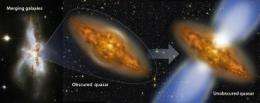After growth spurt, supermassive black holes spend half their lives veiled in dust

Supermassive black holes found at the centers of distant galaxies undergo huge growth spurts as a result of galactic collisions, according to a new study by astronomers at Yale University and the University of Hawaii. Their findings appear in the March 25 edition of Science Express.
As massive, gas-rich galaxies in the distant universe collide, the central black hole feeds on gas that is funneled to the center of the merger. "As a result of the violent, messy collision, the black hole also remains obscured behind a 'veil' of dust for between 10 million and 100 million years," said Priyamvada Natarajan, professor of astronomy at Yale and one of the paper's authors. After that time the dust is blown away to reveal a brightly shining quasar—the central region of a galaxy with an extremely energetic, supermassive black hole at its center—that lasts for another 100 million years, the team found.
Until now, astronomers were unsure how long the quasars spent behind the dust cloud. While unobscured quasars, which are the brightest optical objects in the early universe, were discovered in the late 1950s, examples of quasars obscured by dust were more difficult to detect, and were only discovered in the late 1990s. "For many years, astronomers believed that these sources were very rare. Now we are seeing them everywhere," said Ezequiel Treister of the University of Hawaii, lead author of the study.
The team used observations from the Hubble, Chandra and Spitzer space telescopes to identify a large number of obscured, dust-enshrouded quasars up to 11 billion light years away, when the universe was only about one-fifth its current age. "We detected a signature of very hot dust at infrared and X-ray wavelengths to find these obscured sources," Treister said.
"Once they had been identified, we used Hubble's new Wide Field Camera 3—which astronauts installed last year during the final servicing mission—to confirm that these distant quasars were actually the result of mergers," said Kevin Schawinski, another Yale co-author.
The researchers discovered that the number of obscured quasars relative to the unobscured ones was significantly larger in the early universe than it is now, giving them a new understanding of how these objects formed and evolved over time. "We knew from theoretical models that mergers of massive, gas-rich galaxies were more frequent in the past," said Natarajan, the theorist of the team. "Now we've found that these mergers are responsible for producing both the nearby obscured quasar population and their distant cousins."
The astronomers coupled the telescope observations with estimated galaxy merger rates and theoretical models to come up with the amount of time it takes for the black hole to blow away the surrounding dust and gas and reveal the naked, bright quasar. "We found that these growing black holes spend about half their lives veiled in dust, and half their lives unveiled," Natarajan said. "That means that, until now, we have likely been missing half of the actively growing black holes in the early universe."
Major galaxy mergers are important triggers for star formation as well as modifying galaxy shape and structure. "This work confirms that mergers are also critical for the growth and evolution of central giant black holes, which continue to feed and gain weight during both the hidden phase and when they shine freely," Natarajan said.
More information: Citation: Major Galaxy Mergers and the Growth of Supermassive Black Holes in Quasars, Science Express (March 25)
Provided by Yale University

















